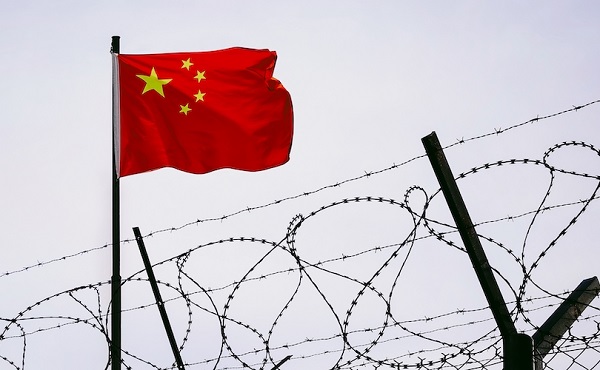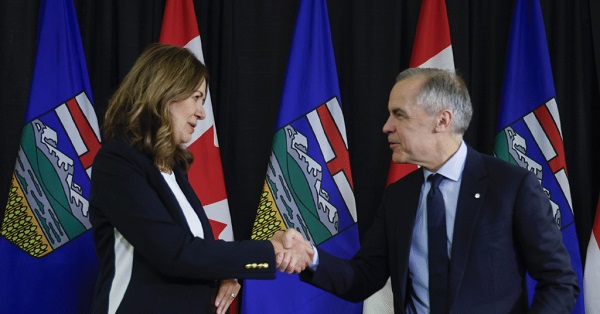By Brian Zinchuk
We’ve seen this before, of course… The Soviets under Lenin and Stalin, and Maoists in China made denunciation commonplace. Don’t like someone? Denounce them for anti-revolutionary speech and have them hauled off to the gulag for 10 years
In the waning days of June, the federal Liberal government, supported by the New Democratic Party, passed legislation to take away some of the rights to free speech in Canada.
Bill C-59 was an omnibus budget bill, which meant its passage was assured lest the government fall. And there are some amendments to the Competition Act within C-59 which are effectively a gag law for you, me, and everybody else.
Gag law
I honestly wasn’t aware of it until Minister of Justice and Attorney General Bronwyn Eyre held a press scrum at the Saskatchewan Oil and Gas Show on June 5 to talk about this. She called it a “gag law,” and it has become evident those were very fitting words.
The additions to the budget impact the Competition Act, for the purpose of eliminating “greenwashing.” The significant clauses state:
“A person engages in reviewable conduct who, for the purpose of promoting, directly or indirectly, the supply or use of a product or for the purpose of promoting, directly or indirectly, any business interest, by any means whatever …
“(b.1) Makes a representation to the public in the form of a statement, warranty or guarantee of a product’s benefits for protecting or restoring the environment or mitigating the environmental, social and ecological causes or effects of climate change that is not based on an adequate and proper test, the proof of which lies on the person making the representation;
“(b.2) Makes a representation to the public with respect to the benefits of a business or business activity for protecting or restoring the environment or mitigating the environmental and ecological causes or effects of climate change that is not based on adequate and proper substantiation in accordance with internationally recognized methodology, the proof of which lies on the person making the representation.”
The penalties for a corporation can be up to three per cent of global revenue.
Charlie Angus’ influence
The Bill was introduced last November, but these portions were amended since then. And you can see from a briefing submission from the environmental lobby, some of their suggestions were implemented.
It also seems to be an extension of Charlie Angus private members bill, which was banning the promotional petroleum in early February. I think that was a trial balloon. No one really thought anything would come of it, but the essence of that bill was already in Section 236 of C-59, with amendments made at the very end of the budgetary process.
This move seems to be a back-door implementation of NDP MP Charlie Angus’ private members bill, Bill C-372, which sought to shut down all oil and gas advertising. Angus’ press release said, “Passage of Bill C-372 will mean that no fossil fuel company will be able to advertise, promote their products, nor mislead the public about the health and environmental threats posed by the burning of fossil fuels, which the World Health Organization now says is the biggest global health threat of the 21st century.”
Isn’t that eerily similar to the clauses noted above?
Saskatchewan calls it a gag law
Eyre told reporters on June 5, “This is a gag law. It’s a federal gag law. It’s Charlie Angus’ fossil fuels advertising act in another form, and it is very serious. That’s what the letter expresses, our profound alarm at this rushed bill, Bill C-59, which is part of an omnibus budget bill. It was rushed, it was done without consultation with any of the provinces. And it could have a very profound effect, very sobering effect harmful effects on our economy, frankly, so very, very concerned about C-59.”
Premier Scott Moe posted on social media on July 2, “It’s a wonder why the federal government would want to put a gag order on Saskatchewan oil and gas companies when they are having great success with their emission reductions. In fact, our energy sectors greenhouse gas emissions last year were 67 per cent below levels reported in 2015. Our government will continue to fight against the Liberal-NDP Coalition Bill C-59 plan in order to protect Saskatchewan’s energy sector.”
Such a statement, made by a provincial premier, no less, could possibly be considered afoul of the law, if he had made these statements after June 20, 2025, when the law is implemented.
Did Moe quote “proper substantiation in accordance with internationally recognized methodology?” After all, according to the law of the land now, “the proof of which lies on the person making the representation.”
Jordan Peterson persecution
The implementation of this law is essentially modelled on the persecution (and I don’t use that term lightly) of Dr. Jordan Peterson.
As noted by the National Post, Dr. Peterson’s plight was that the “College of Psychologists of Ontario that ordered Jordan Peterson into a mandatory rehabilitation program for his politically incorrect tweets, which had nothing to do with his practice and involved none of his patients.”
Among the complaints made against him was the submission of the entire transcript of his appearance on the Joe Rogan Experience podcast! And an Ontario court backed up the College’s prosecution (persecution?) of him!
Bill C-59 conjures up a similar system. As energy advocate Deidra Garyk writes in Pipeline Online, “While focus has been on the muzzling of oil and gas supporters and companies, this bill is agnostic and, therefore, allows all industries to be targeted. Although, oil and gas is likely to be disproportionately aimed at and penalized since anyone can go onto the Bureau’s website and easily complete a complaint form. You do not have to be a victim to file a complaint, meaning a company can be accused of a victimless crime.”
Communist-style denunciation
We’ve seen this before, of course, long before Peterson’s problems. The Soviets under Lenin and Stalin, and Maoists in China made denunciation commonplace. Don’t like someone? Denounce them for anti-revolutionary speech and have them hauled off to the gulag for 10 years, but only if they don’t catch a bullet behind the ear, first.
Process is the punishment
While Canadians aren’t likely to catch a bullet, yet, this is a situation where the process is the punishment. It doesn’t matter if the complainants win. All they have to do is initiate the process, and you are in a world of hurt.
And trust me, they will be filing complaints. Expect groups like Ecojustice, Sierra Club, and Greenpeace to be lining them up as we speak. In December, several of them, including Ecojustice, submitted a briefing note “amending Bill C-59 to more effectively combat greenwashing.”
A few clicks online and bam! You’re tied up in litigation that’s from tens to hundreds of thousands of dollars.
And even if you win, you still lose, because you’ve paid all that money for the lawyers and the time and effort.
And in the meantime, while you’re in litigation, you’re not going to say a damn thing until it’s resolved. So, you have effectively been muted until the court process, which is never quick and efficient, is dealt with. Again, the process is the punishment.
Easier to say nothing, ever
Now, the solution for most people, and most companies, will realize is that it’s easier not to say anything at all, which effectively silences you. As Eyre said, this is a gag law.
And you know what really, really troubling?
Some of the largest companies in Canada, corporations with literally floors of lawyers among them, folded like a house of cards as soon as C-59 became law. The Pathways Alliance, made up of the six largest oilsands producers, promptly wiped their website clean. The Canadian Association of Petroleum Producers, on June 20, said it “has chosen to reduce the amount of information it makes available on its website and other digital platforms until the Competition Bureau has released further guidance on how these amendments will be implemented.”
So the gag has been thoroughly applied, already. Spines, and perhaps some other bodily parts, are notably absent.
And these are the organizations with by far the largest resources to fight this assault on free speech. Instead, they issued press releases. Big deal. That press release should have said they will fight this tooth and nail. Instead, They’ve already all but given up.
So what the hell am I supposed to do, working in my basement as a one man band? I have no financial resources to pay for any sort of legal fight.
How the hell am I supposed to fight this when the people who have all the resources in the world, in this country have said, “Oh, we’ll put up a press release saying, ‘We don’t like this, but we’re not going to do anything about it.’”
I’ll tell you what my defence is, should I, or my corporation, Pipeline Online Ltd., have a complaint issued under this legislation: Section 2(b) of the Canadian Charter of Rights and Freedoms. It states, “Everyone has the following fundamental freedoms: (b) freedom of thought, belief, opinion and expression, including freedom of the press and other media of communication.”
That includes the right to say whatever you want about “protecting or restoring the environment or mitigating the environmental, social and ecological causes or effects of climate change.”
And under Canadian law, corporations have rights, too.
ESG as the rope to hang you
And here’s another twist: in the last four years, environment, social and governance, or ESG statements or reports have went from non-existent to required if you expect any sort of institutional investment. No ESG report; no money, honey.
But these very reports, the ones making companies’ environmental cases, will now be rope with which the likes of Ecojustice and Greenpeace will hang them. Now if you publish an ESG statement, your critics can use that as evidence to prosecute you. So you’re damned if you do, and you’re damned if you don’t. If you don’t put out an ESG statement, maybe you’ll lose all your investors. And if you do publish it, well, maybe you’ll get prosecuted by this for saying the wonderful stuff that you have tried to do for the environment.
What if a journalist like me comes around and does a story on your company? Let’s give a real example. Several years ago, a drilling company which no longer exists called CanElson converted many of it rigs to operate on dual-fuel; diesel and compressed natural gas. And one of the reasons cited at the time when I wrote about it was the environmental benefits from lower emissions. But now, lawyers would almost certainly tell them everything they say would have to be couched with “proper substantiation in accordance with internationally recognized methodology.” In other words, mountains of fine print. But no press organization is going to publish all of that, and the company would have no control over what is published. So that company’s lawyer would, according to the new law, obviously advise their clients to say nothing, ever, to any media where it could be published, lest they open themselves up to prosecution under the Competition Act, as amended by Bill C-59.
Again, a gag law.
1984
This is really an implementation of George Orwell’s 1984, where groupthink has been legislated into law a couple week ago by the federal government. If you say anything against the current orthodoxy of anthropogenic climate change, or even if your efforts to support it are found insufficient, you are an apostate and can be prosecuted for it.
This is not hyperbole. This has really happened.
Your freedom of speech, today, is dramatically reduced from what it was on June 19.
And we allowed it to happen.
Authoritarian pattern
This reminds me of how the Russian Revolution evolved under the Soviets, as recorded by Aleksandr Solzhenitsyn’s The Gulag Archipelago. First they came for the Mensheviks, then the socialists. Then they came for the bourgeois business owners and clergy. Next were the engineers, which were called “wreckers,” as well as the intelligentsia. Then they came for the kulaks, which were farmers who had as few as three cows, leading to the Holodomor. Then they came for the military, in the great purge.
This is the route authoritarianism takes. Free speech is the first to go. What comes after that?
I’ve been talking to a number of people about this in recent weeks. Some have suggested working within the system as it now exists, under the new changes to the Competition Act. Some have suggested using the new rules to fight back, making complaints about the green lobby, instead.
That’s a fool’s errand. You’re co-opting the authoritarians’ plan. Just like the Jews who dutifully donned their yellow Stars of David. If we just do what they tell us to, work within their new rules, maybe they’ll leave us alone.
How did that work out?
I wore a uniform as a reservist officer in the Canadian Forces. I may have been the lowest form of reservist officer, but I still wore a uniform for seven years, and there’s no way in hell I am going to be gagged by my own federal government for being able to say what I’m going to say.
And the fact that CAPP and the Pathways Alliance folded on this like a cheap house of cards, is all the more troubling. They’ve just been handed the environmental equivalent of a yellow star, and they dutifully put it on.
Will you do the same?
Brian Zinchuk is editor and owner of Pipeline Online, and occasional contributor to the Frontier Centre for Public Policy. He can be reached at [email protected].






















